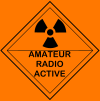Emergency Communication Exercise Set in Northern Florida
On Sunday, March 1, dozens of amateur radio volunteers from several states will take part in a 3-hour exercise in the northern Florida city of Gainesville. The exercise is designed to test and evaluate skills, assets, and strategies for emergency communication, such as those that might be needed in the aftermath of a hurricane. The exercise is being organized by the North Florida Amateur Radio ...
VP8PJ South Orkney Islands DXpedition Anticipates Being on the Air on Sunday, February 23
The VP8PJ DXpedition to South Orkney Islands now anticipates being on the air sometime on Sunday, February 23, a couple of days behind the projected schedule. “The process of assembling the camp continues,” the DXpedition team reported on February 21. “[G]oing well, but will continue throughout today and tomorrow.” And in a follow-up report, “The ice has cleared enough to get the equipment asho...
Include some interesting shortwave radio audio files, recorded BC stations, and a large colletion of SWL QSL cards
York Hamfest
York, PA, hamfest and computer show
The Amateur Television Network
Fast Scan Amateur Television in Alabama, Arizona, Northern California
Southern California, Georga, Illinois, Indiana, Kentucky, New Mexico, Nevada,
Texas, Washington, Delaware, Maryland, New Jersey, and Pennsylvania.
Bishops Stortford Amateur Radio Society
The Bishop's Stortford and District Amateur Radio Society founded in 1967
Historian Wanted
The New Zealand Association of Radio Transmitters (NZART) is looking for a Historian
Ham radio club gets free publicity on TV station
WBNG News reports the Binghamton Amateur Radio Association met for one of their regular meetings Wednesday night- something this organization has been doing locally for decades
Yasme Foundation Grants and Excellence Awards
The Board of Directors of The Yasme Foundation announces that it has made the following grants at its board meeting in Orlando, Florida
ARRL Great Lakes Division Convention
The Great Lakes Division Convention will be held in conjunction with the Toledo Mobile Radio Association’s annual hamfest in Perrysburg, OH, on March 14th and 15th
9J2LA Zambia DXpedition news
Some good news have to be shared. After an endless long process to get our Zambian license we are finally there. A big thanks to Mario/9J2MYT (IK1MYT) and Brian/9J2BO in Lusaka who helped us achieving this important goal. The license has been received just before the weekend
NEMO-1 Ham Radio Buoy report
On January 30 at noon, AMSAT ARGENTINA launched the NEMO-1 buoy into the Atlantic sea, callsign LU7AA. It was transported 70 km east of Mar del Plata by the fishing vessel 'Porteño', from Sandokan
Puerto Rico TV features ham radio
On February 18 the 4 PM newscast of TV station WAPA highlighted the importance of amateur radio for emergency communications in Puerto Rico
Coronavirus outbreak postpones DXpedition
The ARRL report the W8S DXpedition to Swains Island in the Pacific, set to take place in mid-March, has been postponed until Fall due to coronavirus travel restrictions
WA9ZCO Wins the February QST Cover Plaque Award
The winning article for the February 2020 QST Cover Plaque award is “CW Combo Key” by Marc Alan Winzenried, WA9ZCO. The QST Cover Plaque Award -- given to the author or authors of the most popular article in each issue -- is determined by a vote of ARRL members on the QST Cover Plaque Poll web page. Cast a ballot for your favorite article in the March issue today.
Ham licence in Thailand
Ham Radio licencing in thailand by on4afu
NC4FB Amateur Radio
Online self-study programs for U. S. Amateur Radio license exams, Canadian Amateur Radio exams, and FCC Commercial Elements 1, 3, 7, 7R, 8 and 9.
Huntingdonshire ARS
Formed in 1987, serve the west part of Cambridgeshire that straddles the valley of the river Great Ouse and was the old county of Huntingdonshire. This includes the market towns of Huntingdon, St Neots, St Ives and Ramsey.
70 MHz bandplan
The long range bandplan for 70 MHz by OZ2M
Portable Mast
Antennas/Masts and mounts
This is a schematic drawing of a project for the construction of a portable mast that can easily be made with PVC pipes.
Configure FLDigi on MacOSX to IC-7100
Radio Equipment/HF Transceivers/Icom IC-7100
Ho to properly configure the FLDigi software running on a MacOS to connect to the Icom IC-7100. Article includes snapshots of I/O ports configuration settings.
Upcoming AMSAT Events
Want to see AMSAT in action or learn more about amateur radio in space? AMSAT Ambassadors provide presentations, demonstrate communicating through amateur satellites, and host information tables at club meetings, hamfests, conventions, maker faires, and other events
SARL RTTY Contest and 40m Club Sprint
The SARL RTTY Contest takes place from 14:00 UTC to 17:00 UTC on Sunday 23 February 2020 with activity on 80, 40 and 20 metres. Thw SARL 95 40 m Club Sprint takes place on Saturday 29 February
Spy radio found during archaeological dig
A 30-year-old Soviet spy radio has been found by archaeologists in a site cleared for a new lignite mine about 30 km west of Köln in Germany
Historic TV news report on ham radio rally
On April 9, 1990 TV station RTE broadcast a news item about the Lough Erne Radio Rally in Northern Ireland
National society acts over Smart Meter interference
IARU Region 2 reports in Saint Kitts amateur radio operators are still battling with the RF Interference, noise and frequency jamming caused by the smart meters of the electric company
Coronavirus Outbreak Postpones Swains Island W8S DXpedition
The W8S DXpedition to Swains Island in the Pacific, set to take place in mid-March, has been postponed until fall as a result of travel restrictions imposed on individuals entering American Samoa, stemming from the recent coronavirus outbreak. The Department of Health allows non-residents to enter American Samoa only via Hawaii after a 14-day mandatory quarantine in Hawaii, and the DXpedition w...
ARISS Radio Telebridge Stalwart Gerald Klatzko, ZS6BTD, SK
When the International Space Station (ISS) orbit is not favorable for a direct Amateur Radio on the International Space Station (ARISS) contact with a particular school or location scheduled to speak with an astronaut, ARISS radio telebridge stations bridge the gap. Gerald Klatzko, ZS6BTD, of Parklands, South Africa, one of the “regulars” during the earlier years of the ARISS program, died on F...
Clinton County Amateur Radio Association
The Clinton County Amateur Radio Association - Club Call W8GO
IK2QIN Renato
QSL manager for GW/IK2QIN - GM/IK2QIN - G/IK2QIN DL/IK2QIN - IS0/IK2QIN - F/IK2QIN TK/IK2QIN - IM0M
South Hills Amateur Radio Club
Pittsburgh's largest ham radio site.
Magnetic crack sparks rare blue auroras
Yes, there really are cracks in Earth's magnetic field. One of them opened on Feb. 18th, sparking some of the strangest auroras in years--including rare blue auroras over Norway
ICQPodcast - South Essex Rally Review
In this episode, Martin M1MRB is joined by Chris Howard M0TCH, Martin Rothwell - M0SGL, Frank Howell - K4FMH and Bill Barnes - N3JIX to discuss the latest Amateur / Ham Radio news. Colin M6BOY rounds up the news in brief and this episode’s feature is - South Essex Rally Review
Lots of new DXCC on HamSphere 4.0
A lot of new DXCC on HamSphere 4.0 since it is possible for hams who are registered on QRZ.COM and HamSphere members to work remote station on exotique QTHs like Clipperton island, etc
David Lloyd to present The Story of Radio
David writes: The landmark 100th anniversaries of radio are now being hit. The first entertainment broadcast by a celebrity, the first 'radio station', the first news bulletin - and the birth of the BBC. At Burgh House in Hampstead on March 4th, I've been invited to tell 'The Story of Radio'
|









